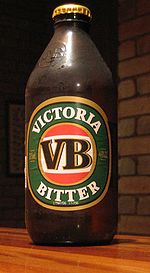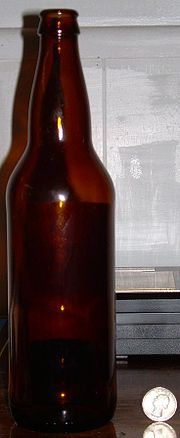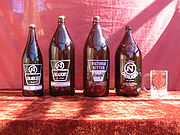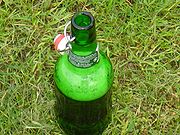
Beer bottle
Encyclopedia

Bottle
A bottle is a rigid container with a neck that is narrower than the body and a "mouth". By contrast, a jar has a relatively large mouth or opening. Bottles are often made of glass, clay, plastic, aluminum or other impervious materials, and typically used to store liquids such as water, milk, soft...
made to contain beer
Beer
Beer is the world's most widely consumed andprobably oldest alcoholic beverage; it is the third most popular drink overall, after water and tea. It is produced by the brewing and fermentation of sugars, mainly derived from malted cereal grains, most commonly malted barley and malted wheat...
, usually made of glass
Glass
Glass is an amorphous solid material. Glasses are typically brittle and optically transparent.The most familiar type of glass, used for centuries in windows and drinking vessels, is soda-lime glass, composed of about 75% silica plus Na2O, CaO, and several minor additives...
.
Bottled beer has been in use since as early as the 16th century. Beer bottles come in various sizes, shapes and colours.
Dark amber or brown glass greatly reduces UV light from spoiling the beer. However, lighter colored bottles are often used for marketing reasons.
The common alternative/competition to glass bottles are beverage can
Beverage can
A beverage can is a tin can designed to hold a specific portion of a beverage. Beverage cans are made of tin-plated steel or aluminium.- History :...
s and aluminum bottle
Aluminum bottle
The aluminium bottle is a bottle made of aluminium or aluminum . In some countries, it is also referred to as a bottlecan, is a bottle made entirely of aluminium that holds beer, soft drinks, wine, and other liquids.- History & overview :...
s.
History
Bottled beer has been in use since as early as the 16th century.Alexander Nowell
Alexander Nowell
Alexander Nowell was an English Puritan theologian and clergyman, who served as dean of St Paul's during much of Elizabeth I's reign.-Biography:...
is said to have taken bottled beer when angling on the River Thames.
Bottling lines
Bottling lines are production lineProduction line
A production line is a set of sequential operations established in a factory whereby materials are put through a refining process to produce an end-product that is suitable for onward consumption; or components are assembled to make a finished article....
s that fill beer into bottles on a large scale.
This typically involves drawing beer from a holding tank and filling it into bottles in a filling machine (filler), which are then capped, labeled and packed into cases or cartons. Many smaller breweries send their bulk beer to large facilities for contract
Contract
A contract is an agreement entered into by two parties or more with the intention of creating a legal obligation, which may have elements in writing. Contracts can be made orally. The remedy for breach of contract can be "damages" or compensation of money. In equity, the remedy can be specific...
bottling—though some will bottle by hand.
The first step in bottling beer is depalletising, where the empty bottles are removed from the original pallet
Pallet
A pallet , sometimes called a skid, is a flat transport structure that supports goods in a stable fashion while being lifted by a forklift, pallet jack, front loader or other jacking device. A pallet is the structural foundation of a unit load which allows handling and storage efficiencies...
packaging delivered from the manufacturer, so that individual bottles may be handled. The bottles may then be rinsed with filter
Filter (chemistry)
In chemistry and common usage, a filter is a device that is designed to physically block certain objects or substances while letting others through. Filters are often used to remove solid substances suspended in fluids, for example to remove air pollution, to make water drinkable, and to prepare...
ed water or air, and may have carbon dioxide
Carbon dioxide
Carbon dioxide is a naturally occurring chemical compound composed of two oxygen atoms covalently bonded to a single carbon atom...
injected into them in attempt to reduce the level of oxygen within the bottle. The bottle then enters a "filler" which fills the bottle with beer and may also inject a small amount of inert gas
Inert gas
An inert gas is a non-reactive gas used during chemical synthesis, chemical analysis, or preservation of reactive materials. Inert gases are selected for specific settings for which they are functionally inert since the cost of the gas and the cost of purifying the gas are usually a consideration...
(CO2
Carbon dioxide
Carbon dioxide is a naturally occurring chemical compound composed of two oxygen atoms covalently bonded to a single carbon atom...
or nitrogen) on top of the beer to disperse oxygen
Oxygen
Oxygen is the element with atomic number 8 and represented by the symbol O. Its name derives from the Greek roots ὀξύς and -γενής , because at the time of naming, it was mistakenly thought that all acids required oxygen in their composition...
, as O2 can ruin the quality of the product by oxidation.
Next the bottle enters a labelling machine ("labeller") where a label is applied. The product is then packed into boxes and warehouse
Warehouse
A warehouse is a commercial building for storage of goods. Warehouses are used by manufacturers, importers, exporters, wholesalers, transport businesses, customs, etc. They are usually large plain buildings in industrial areas of cities and towns. They usually have loading docks to load and unload...
d, ready for sale.
Stubby

Stubbies are used extensively in Europe, and were used almost exclusively in Canada from 1962 to 1986 as part of a standardization effort intended to reduce breakage, and the cost of sorting bottles when they were returned by customers. Due to their nostalgic value, stubbies were reintroduced by a number of Canadian craft brewers in the early 2000s. In the U.S., stubbies have generally fallen out of favour, with only a few brands still using them such as the Session Lager
Lager
Lager is a type of beer made from malted barley that is brewed and stored at low temperatures. There are many types of lager; pale lager is the most widely-consumed and commercially available style of beer in the world; Pilsner, Bock, Dortmunder Export and Märzen are all styles of lager...
by the Full Sail Brewing Company
Full Sail Brewing Company
Full Sail Brewing Company is a craft brewery in Hood River, Oregon, United States. Founded in 1987, Full Sail was the first commercially successful craft brewery to bottle beer in the Pacific Northwest for retail sale, and one of Oregon's early microbreweries...
, and Red Stripe
Red Stripe
Red Stripe is a Jamaican lager beer whose logo is a bold, diagonal red stripe. It is brewed by Desnoes & Geddes Limited, originally a soft drink manufacturer incorporated on July 31, 1918, by Kingston, Jamaica natives Eugene Peter Desnoes and Thomas Hargreaves Geddes...
, a Jamaican brand import.
The 2 litre "Darwin Stubby" is available in Australia's Northern Territory. The Darwin Stubby was first introduced in April 1958 with an 80 impfloz capacity.
De Nederlandse Bierfles (pijpje)

Britain
Through the latter part of the 20th century, most British brewers used a standard design of bottle, known as the London Brewers' Standard. This was in brown glass, with a conical medium neck in the pintPint
The pint is a unit of volume or capacity that was once used across much of Europe with values varying from state to state from less than half a litre to over one litre. Within continental Europe, the pint was replaced with the metric system during the nineteenth century...
and with a rounded shoulder in the half-pint and nip sizes. Pints (568 mL) and half-pints (284 mL) were the most common, but some brewers also bottled in nip
Alcohol measurements
Alcohol measurements are Units of measurement for determining amounts of alcohol.-Beer measures:* snorkel - 2 fluid ounces* nip - 1/3 pint...
(1/3-pint) and quart
Quart
The quart is a unit of volume equal to a quarter of a gallon, two pints, or four cups. Since gallons of various sizes have historically been in use, quarts of various sizes have also existed; see gallon for further discussion. Three of these kinds of quarts remain in current use, all approximately...
(2-pint) sizes. It was for example mostly barley wine
Barley wine
Barley wine or Barleywine is a beer style of strong ale originating in England. The first beer to be marketed as Barley Wine was Bass No. 1 Ale, around 1870...
s that were bottled in nips, and Midlands breweries such as Shipstone of Nottingham that bottled in quarts. This standardisation simplified the automation
Automation
Automation is the use of control systems and information technologies to reduce the need for human work in the production of goods and services. In the scope of industrialization, automation is a step beyond mechanization...
of bottling and made it easier for customers to recycle
Recycling
Recycling is processing used materials into new products to prevent waste of potentially useful materials, reduce the consumption of fresh raw materials, reduce energy usage, reduce air pollution and water pollution by reducing the need for "conventional" waste disposal, and lower greenhouse...
bottles as they were interchangeable. They carried a deposit charge, which in the 1980s rose to 7 pence for a pint and 5 pence for a half-pint. Some brewers however used individual bottle designs: among these were Samuel Smith, which used an embossed clear bottle, and Scottish and Newcastle, which used a clear bottle for their Newcastle Brown Ale (both designs survive in the 500 mL size today). Other brewers such as Timothy Taylor had used their own embossed bottles and rare examples continud to be reused into the 1980s. At around the turn of the 21st century the industry turned away from refillable bottles and UK beer bottles are now all one-trip, and most are 330ml in volume.
Longneck, Industry Standard Bottle (ISB) or North American longneck
A North American longneck is a type of beer bottle with a long neck. It is known as the standard longneck bottle or industry standard bottle (ISB). The ISB longnecks have a uniform capacity, height, weight and diameter and can be reused on average 16 times. The long neck offers a long cushion of air to absorb the pressure of carbonation to reduce the risk of exploding. In Canada, in 1992, the large breweries agreed to all use a 341 mL longneck bottle of standard design (named AT2), thus replacing the traditional stubby bottle and an assortment of brewery-specific long-necks which had come into use in the mid-1980s. In Australia the term longneck is applied to bottles of 700-750 mL capacity.
Large bottles
In USA large bottles are 22 U.S.floz (colloquially called a "rocket" or "bomber" ); the European standard large bottle is 750 millilitre (in South Africa and Canada referred to as a "quart")Forty
A forty is American slangSlang
Slang is the use of informal words and expressions that are not considered standard in the speaker's language or dialect but are considered more acceptable when used socially. Slang is often to be found in areas of the lexicon that refer to things considered taboo...
for a 40 U.S.floz bottle commonly used for cheaper varieties of beer and of malt liquor
Malt liquor
Malt liquor is a North American term referring to a type of beer with high alcohol content. In legal statutes, the term often includes any alcoholic beverage above or equal to 5% alcohol by volume made with malted barley. In common parlance, however, it is used for high-alcohol beers made with...
.
Growler
A growler is a glass jug with a capacity of 0.5 gallons (1,892.7 ml) used to transport draft beer in Australia, the United States and Canada. They are commonly sold at breweriesBrewery
A brewery is a dedicated building for the making of beer, though beer can be made at home, and has been for much of beer's history. A company which makes beer is called either a brewery or a brewing company....
and brewpubs as a means to sell take-out
Take-out
Take-out or takeout , carry-out , take-away , parcel , or tapau , is food purchased at a...
beer. Some breweries also offer a one-litre or one-quart version.
Growlers are generally made of glass and have either a screw-on cap or a hinged porcelain gasket cap, which can provide freshness for a week or more. A properly sealed growler will hold carbonation
Carbonation
Carbonation is the process of dissolving carbon dioxide in water. The process usually involves carbon dioxide under high pressure. When the pressure is reduced, the carbon dioxide is released from the solution as small bubbles, which cause the solution to "fizz." This effect is seen in carbonated...
indefinitely and will store beer like any other sanitized bottle. Some growler caps are equipped with valves to allow replacement of CO2 lost while racking. The modern glass growler was first introduced by Charlie and Ernie Otto of Otto Brother's Brewing Company in 1989.
The term likely dates back to the late 19th century when fresh beer was carried from the local pub to one's home by means of a small galvanized pail. Often the inside of the pail would be coated with lard to decrease foam and allow for slightly more beer to be in the pail. It is claimed the sound that the CO2 made when it escaped from the lid as the beer sloshed around sounded like a growl.
Australia's "Darwin Stubby"

Kitsch
Kitsch is a form of art that is considered an inferior, tasteless copy of an extant style of art or a worthless imitation of art of recognized value. The concept is associated with the deliberate use of elements that may be thought of as cultural icons while making cheap mass-produced objects that...
status in Australian folklore.
Caguama bottles
In Mexico, "caguama" is a popular name for a 940 millilitre beer bottle. The Mexican beer brands which are sold in these bottles include Tecate, Carta Blanca, Sol, Indio, Victoria, Corona Familiar and PacíficoPacífico
Cerveza Pacífico Clara, better known as Pacifico, is a Mexican pilsner-style beer. It was first brewed in 1900 when three Germans opened a brewery, the Cerveceria del Pacífico in Mazatlán. Cerveza Pacifico is named so because the Pacifico brewery is located in the Pacific Ocean port city of...
. In some parts of northern Mexico, "caguamas" are "ballenas" meaning whale in Spanish.
Closure

Bottle cap
Bottle caps are a type of closure used to seal the openings of bottles of many types. They can be small circular pieces of metal, usually steel, with plastic backings, and for plastic bottles a plastic cap is used instead. A bottle cap is typically colorfully decorated with the logo of the brand...
, but most often with crown cork
Crown Cork
The crown cork , the first form of bottle cap, was invented by William Painter in 1891 in Baltimore. The company making it was originally called the Bottle Seal Company, but it changed its name with the almost immediate success of the crown cork to the Crown Cork and Seal Company...
s. Some beers (most notably Grolsch
Grolsch Brewery
Grolsch Brewery , known simply as Grolsch , is a Dutch brewery founded in 1615 by Willem Neerfeldt in Groenlo. In 1895 the De Groen family bought the brewery. They had started their own brewery in Cuijk the Netherlands in early 1800. It held a significant stake until November 2007...
) are sold in "beugel" style bottles, known as "swing top" in some English speaking countries and as "lightning stoppers" in Australia, presumably because they could be opened and closed easily. These bottles were superseded by the crown cork
Crown Cork
The crown cork , the first form of bottle cap, was invented by William Painter in 1891 in Baltimore. The company making it was originally called the Bottle Seal Company, but it changed its name with the almost immediate success of the crown cork to the Crown Cork and Seal Company...
at the end of the 19th century, but survive in premium markets as nostalgic
Nostalgia
The term nostalgia describes a yearning for the past, often in idealized form.The word is a learned formation of a Greek compound, consisting of , meaning "returning home", a Homeric word, and , meaning "pain, ache"...
items.
Use as weapons
Beer bottles are sometimes used as makeshift clubClub (weapon)
A club is among the simplest of all weapons. A club is essentially a short staff, or stick, usually made of wood, and wielded as a weapon since prehistoric times....
s, for instance in bar fights. Pathologists
Forensic pathology
Forensic pathology is a branch of pathology concerned with determining the cause of death by examination of a corpse. The autopsy is performed by the pathologist at the request of a coroner or medical examiner usually during the investigation of criminal law cases and civil law cases in some...
determined in 2009 that beer bottles are strong enough to crack human skulls, which requires an impact energy
Energy
In physics, energy is an indirectly observed quantity. It is often understood as the ability a physical system has to do work on other physical systems...
of between 14 and 70 joule
Joule
The joule ; symbol J) is a derived unit of energy or work in the International System of Units. It is equal to the energy expended in applying a force of one newton through a distance of one metre , or in passing an electric current of one ampere through a resistance of one ohm for one second...
s, depending on the location. Empty beer bottles shatter at 40 joules, while full bottles shatter at only 30 joules because of the pressure of the carbonated
Carbonation
Carbonation is the process of dissolving carbon dioxide in water. The process usually involves carbon dioxide under high pressure. When the pressure is reduced, the carbon dioxide is released from the solution as small bubbles, which cause the solution to "fizz." This effect is seen in carbonated...
beer inside the bottle. While it takes less energy to break a full beer bottle, the extra mass
Mass
Mass can be defined as a quantitive measure of the resistance an object has to change in its velocity.In physics, mass commonly refers to any of the following three properties of matter, which have been shown experimentally to be equivalent:...
in a full bottle will impart more damage. A test performed by the Mythbusters
MythBusters
MythBusters is a science entertainment TV program created and produced by Beyond Television Productions for the Discovery Channel. The series is screened by numerous international broadcasters, including Discovery Channel Australia, Discovery Channel Latin America, Discovery Channel Canada, Quest...
showed that full bottles are significantly more dangerous than empty bottles. Full bottles inflict more damage in terms of concussion and skull fracture
Skull fracture
A skull fracture is a break in one or more of the bones in the skull usually occurring as a result of blunt force trauma. If the force of the impact is excessive the bone may fracture at or near the site of the impact...
; however, both full and empty bottles do the same amount of damage in scalp lacerations.
For this reason, long-neck beer bottles have been banned in some places, such as Alice Springs, Australia.
Lightstruck beer
Lightstruck, or "skunked" or "skunky", beer has been exposed to ultraviolet and visible light. The light causes riboflavinRiboflavin
Riboflavin, also known as vitamin B2 or additive E101, is an easily absorbed micronutrient with a key role in maintaining health in humans and animals. It is the central component of the cofactors FAD and FMN, and is therefore required by all flavoproteins. As such, vitamin B2 is required for a...
to react with and break down isohumulone
Isohumulone
Isohumulones are compounds that contribute to the bitter taste of beer. They are in the class of compounds known as iso-alpha acids. The bitterness of beer is measured according to the International Bitterness Units scale, with one IBU corresponding to 1 part per million of isohumulone...
s, a molecule that contributes to the bitterness of the beer and is derived from the hop
Hop (plant)
Humulus, Hop, is a small genus of flowering plants native to temperate regions of the Northern Hemisphere. The female flowers of H. lupulus are known as hops, and are used as a culinary flavoring and stabilizer, especially in the brewing of beer...
s. The resulting molecule, 3-methylbut-2-ene-1-thiol, is very similar chemically and in odour to the musk-borne mercaptans that are a skunk
Skunk
Skunks are mammals best known for their ability to secrete a liquid with a strong, foul odor. General appearance varies from species to species, from black-and-white to brown or cream colored. Skunks belong to the family Mephitidae and to the order Carnivora...
's natural defences.
In some cases, such as Miller High Life, a hop extract that does not have isohumulones is used to bitter the beer so it cannot be "lightstruck". A dark brown glass bottle gives some protection to the beer, but green and clear glass bottles offer virtually no protection at all.
There are also other solutions available to improve beer bottled in clear and green glass from becoming skunked or light-struck. There are specialty coatings that can be baked into the glass and offer additional protection from UV light.
See also
- Aluminum bottleAluminum bottleThe aluminium bottle is a bottle made of aluminium or aluminum . In some countries, it is also referred to as a bottlecan, is a bottle made entirely of aluminium that holds beer, soft drinks, wine, and other liquids.- History & overview :...
- Aluminum canAluminum canAn aluminum can, or can, is a container for packaging made primarily of aluminum .They are commonly used for foods and beverages but also for products such as oil, chemicals, and other liquids. The common 12-ounce size can weighs 15 grams when empty.-Usage:Use of aluminum in cans began in 1957...
- Beer in Australia
- Beverage canBeverage canA beverage can is a tin can designed to hold a specific portion of a beverage. Beverage cans are made of tin-plated steel or aluminium.- History :...
- Box wineBox wineA box wine is a wine packaged as a Bag-In-Box. Such packages contain a plastic bladder protected by a box, usually made of corrugated fiberboard.- History :...
- Container-deposit legislation
- Glass container industry
- Widget (beer)Widget (beer)A widget is a device placed in a container of beer to manage the characteristics of the beer's head. The original widget was patented in Ireland by Guinness. The "floating widget" is found in cans of beer as a hollow plastic sphere, 3 cm in diameter with a small hole in one side...
- Wine bottleWine bottleA wine bottle is a bottle used for holding wine, generally made of glass. Some wines are fermented in the bottle, others are bottled only after fermentation. They come in a large variety of sizes, several named for Biblical kings and other figures. The standard bottle contains 750 ml,...
External links
- Growler Man Hand Crafted Beer Bottles
- Focus on Bottle filling machine
- Historic beer bottles
- Website for The Canadian Stubby Beer Bottle
- Article on stubbies which mentions the newer longnecks.
- The filling machines for beer bottles
- rec.food.drink.beer FAQ
- Curious Cook - In the dark: olive oil, milk, butter, and beer
- An Example of an American Micro Brew Beer Bottle
- "The New Old Way to Tote Your Beer" by Robert Simonson, the New York Times

